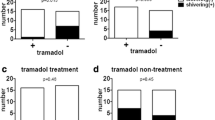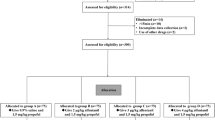Abstract
Purpose
The authors conducted a prospective, randomized, double-blind study to evaluate the anti-shivering efficacy of palonosetron for patients after gynecological laparoscopy under total intravenous propofol–remifentanil anesthesia.
Methods
Sixty female patients were randomly assigned to one of two groups and administered palonosetron 0.075 mg (palonosetron group, n = 30) or the same volume of normal saline (control group, n = 30) immediately after anesthesia induction. Anesthesia was induced and maintained with propofol and remifentanil, using a target-controlled infusion device. Esophageal and index finger temperatures were measured immediately after anesthesia induction (baseline) and at 15-min intervals until the end of the surgery. Postanesthetic shivering and side effects were assessed in a postanesthetic care unit.
Results
Incidence of shivering was comparable in the control and palonosetron groups (10/30 vs. 8/30, respectively, P = 0.779). No significant intergroup differences were observed between esophageal and index finger temperatures. Compared with baseline values, esophageal temperatures decreased immediately after pneumoperitoneum in the control group and from 30 min after pneumoperitoneum in the palonosetron group.
Conclusion
Use of palonosetron (0.075 mg) did not reduce the incidence of postanesthetic shivering after gynecological laparoscopy under propofol–remifentanil anesthesia. Further study including other 5-HT3 antagonists or male patients would elucidate the effect of palonosetron on shivering after propofol–remifentanil anesthesia.


Similar content being viewed by others
References
Crossley AWA. Perioperative shivering. Anaesthesia. 1992;47:193–5.
Bay J, Nunn JF, Prys-Roberts C. Factors influencing arterial PO2 during recovery from anaesthesia. Br J Anaesth. 1968;40:398–407.
Alfonsi P. Postanaesthetic shivering. Epidemiology, pathophysiology and approaches to prevention and management. Minerva Anestesiol. 2003;69:438–42.
Larsen B, Seitz A, Larsen R. Recovery of cognitive function after remifentanil–propofol anesthesia: a comparison with desflurane and sevoflurane anesthesia. Anesth Analg. 2000;90:168–74.
Juckenhöfel S, Feisel C, Schmitt HJ, Biedler A. TIVA with propofol–remifentanil or balanced anesthesia with sevoflurane-fentanyl in laparoscopic operations. Hemodynamics, awakening and adverse effects. Anaesthesist. 1999;48:807–12.
Röhm KD, Riechmann J, Boldt J, Suttner SW, Piper SN. Total intravenous anesthesia with propofol and remifentanil is associated with a nearly twofold higher incidence in postanesthetic shivering than desflurane-fentanyl anesthesia. Med Sci Monit. 2006;12:CR452–6.
Nakasuji M, Nakamura M, Imanaka N, Tanaka M, Nomura M, Suh SH. Intraoperative high-dose remifentanil increases post-anaesthetic shivering. Br J Anaesth. 2010;105:162–7.
Mazzola-Pomietto P, Aulakh CS, Murphy DL. Temperature, food intake, and locomotor activity effects of a 5-HT3 receptor agonist and two 5-HT3 receptor antagonists in rats. Psychopharmacology. 1995;121:488–93.
Komatsu R, Orhan-Sungur M, In J, Podranski T, Bouillon T, Lauber R, Rohrbach S, Sessler DI. Ondansetron does not reduce the shivering threshold in healthy volunteers. Br J Anaesth. 2006;96:732–7.
Powel RM, Buggy DJ. Ondansetron given before induction of anesthesia reduces shivering after general anesthesia. Anesth Analg. 2000;90:423–7.
Sagir O, Gulhas N, Toprak H, Yucel A, Begec Z, Ersoy O. Control of shivering during regional anaesthesia: prophylactic ketamine and granisetron. Acta Anaesthesiol Scand. 2007;51:44–9.
Sajedi P, Yaraghi A, Ali Moseli HA. Efficacy of granisetron in preventing postanesthetic shivering. Acta Anaesthesiol Taiwan. 2008;46:166–70.
Dhimar AA, Patel MG, Swadia NV. Tramadol for control of shivering (comparison with pethidine). Indian J Anaesth. 2007;51:28–31.
Bessell JR, Karatassas A, Petterson JR, Jamieson GG, Maddern GJ. Hypothermia induced by laparoscopic insufflations: a randomized study in a pig model. Surg Endosc. 1995;9:791–6.
Moore SS, Green CR, Wang FL, Pandit SK, Hurd WW. The role of irrigation in the development of hypothermia during laparoscopy surgery. Am J Obstet Gynecol. 1997;176:598–602.
Ikeda T, Sessler DI, Kikura M, Kazama T, Ikeda K, Sato S. Less core hypothermia when anesthesia is induced with inhaled sevoflurane than with intravenous propofol. Anesth Analg. 1999;88:921–4.
Matsukawa T, Sessler DI, Sessler AM, Schroeder M, Ozaki M, Kurz A, Cheng C. Heat flow and distribution during induction of general anesthesia. Anesthesiology. 1995;82:662–73.
Sessler DI. Temperature monitoring. In: Miller RD, editor. Anesthesia. New York: Churchill Livingstone Inc; 1994. p. 1363–82.
Guyton AC. Body temperature, temperature regulation and fever. In: Guyton AC, editor. Textbook of medical physiology. 6th ed. Philadelphia: WB Saunders Inc; 1991. p. 886–98.
Browning RM, Fellingham WH, O’Loughlin EJ, Brown NA, Paech MJ. Prophylactic ondansetron does not prevent shivering or decrease shivering severity during cesarean delivery under combined spinal epidural anesthesia: a randomized trial. Reg Anesth Pain Med. 2012. doi:10.1097/AAP.0b013e31827049c6 (in press).
Rojas C, Stathis M, Thomas AG, Massuda EB, Alt J, Zhang J, Rubenstein E, Sebastiani S, Cantoreggi S, Snyder SH, Slusher B. Palonosetron exhibits unique molecular interactions with the 5-HT3 receptor. Anesth Analg. 2008;107:469–78.
Nakasuji M, Nakamura M, Imanaka N, Tanaka M, Nomura M, Suh SH. An intraoperative small dose of ketamine prevents remifentanil-induced postanesthetic shivering. Anesth Analg. 2011;113:484–7.
Ryu JH, Kang MH, Park KS, Do SH. Effects of magnesium sulphate on intraoperative anaesthetic requirements and postoperative analgesia in gynaecology patients receiving total intravenous anaesthesia. Br J Anaesth. 2008;100:397–403.
Conflict of interest
No external funding was provided for this study, and the authors have no competing interests to declare.
Author information
Authors and Affiliations
Corresponding author
About this article
Cite this article
Jo, Y.Y., Kwak, H.J., Lee, M.G. et al. Effect of palonosetron on postanesthetic shivering after propofol–remifentanil total intravenous anesthesia. J Anesth 27, 535–540 (2013). https://doi.org/10.1007/s00540-013-1556-1
Received:
Accepted:
Published:
Issue Date:
DOI: https://doi.org/10.1007/s00540-013-1556-1




